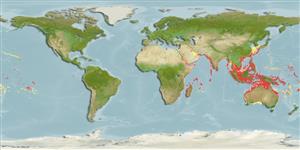Environment: milieu / climate zone / depth range / distribution range
Sinh thái học
Biển; Thuộc về nước lợ Cùng sống ở rạn san hô; Mức độ sâu 1 - 80 m (Ref. 58302). Tropical; 35°N - 35°S, 24°E - 135°W
Indo-Pacific: Red Sea and the east coast of Africa to the Hawaiian Islands and Samoa, north to Japan (Ref. 559), south to the Arafura Sea (Ref. 9819) and northern Australia.
Length at first maturity / Bộ gần gũi / Khối lượng (Trọng lượng) / Age
Maturity: Lm ?, range 17 - ? cm
Max length : 30.0 cm TL con đực/không giới tính; (Ref. 30573); common length : 26.0 cm TL con đực/không giới tính; (Ref. 30573)
Các tia vây lưng cứng (tổng cộng) : 9; Các vây lưng mềm (tổng cộng) : 22 - 25; Tia cứng vây hậu môn: 3; Tia mềm vây hậu môn: 18 - 21. This species is distinguished by the following characters: adipose eyelid well developed and completely covering eye except for a vertical slit centred on pupil; shoulder girdle (cleithrum) margin smooth, without papillae; terminal dorsal and anal rays finlet-like in adults, about twice length of adjacent rays and a little more separated but joined by interradial membrane; lateral line gently arched anteriorly, with junction of curved and straight parts below vertical from sixth to eighth soft rays of second dorsal fin; scales in curved part of lateral line 39 to 57; straight part with 0 to 10 scales and 36 to 49 scutes; a black spot, slightly smaller than eye, on upper margin of opercle and adjacent area of shoulder; dorsal and caudal fins dusky greenish yellow; anal fin pale yellow (Ref. 9894).
Adults inhabit mangroves and coastal bays in pelagic waters (Ref. 58302). They form schools to about 50 m in inshore waters (Ref. 9894), or singly (Ref. 48635). Are mainly diurnal. They feed mainly on crustaceans and planktonic invertebrates such as copepods, including cephalopods (Ref. 5213, 90102). They swim fast in midwater in pursuit of zooplankton (Ref. 48635).
Paxton, J.R., D.F. Hoese, G.R. Allen and J.E. Hanley, 1989. Pisces. Petromyzontidae to Carangidae. Zoological Catalogue of Australia, Vol. 7. Australian Government Publishing Service, Canberra, 665 p. (Ref. 7300)
IUCN Red List Status (Ref. 130435: Version 2024-1)
Threat to humans
Harmless
Human uses
Các nghề cá: buôn bán nhỏ; cá để chơi: đúng
Các công cụ
Special reports
Download XML
Các nguồn internet
Estimates based on models
Preferred temperature (Ref.
123201): 23.8 - 29.1, mean 28 °C (based on 2048 cells).
Phylogenetic diversity index (Ref.
82804): PD
50 = 1.0000 [Uniqueness, from 0.5 = low to 2.0 = high].
Bayesian length-weight: a=0.01349 (0.01204 - 0.01511), b=2.96 (2.93 - 2.99), in cm total length, based on LWR estimates for this species (Ref.
93245).
Mức dinh dưỡng (Ref.
69278): 4.2 ±0.5 se; based on diet studies.
Thích nghi nhanh (Ref.
120179): Chiêù cao, thời gian nhân đôi của chủng quần tối thiểu là dưới 15 tháng (K=0.58-1.00; Fec=63,000-161,000 (batch fecundity)).
Fishing Vulnerability (Ref.
59153): Low vulnerability (18 of 100).
Climate Vulnerability (Ref.
125649): Moderate to high vulnerability (47 of 100).
Nutrients (Ref.
124155): Calcium = 79.4 [45.4, 166.2] mg/100g; Iron = 1.04 [0.59, 1.83] mg/100g; Protein = 20 [19, 21] %; Omega3 = 0.193 [0.120, 0.326] g/100g; Selenium = 33.1 [17.7, 62.5] μg/100g; VitaminA = 87.6 [28.1, 279.3] μg/100g; Zinc = 1.17 [0.79, 1.61] mg/100g (wet weight); based on
nutrient studies.
